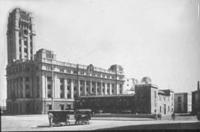
The Council of Tenerife was founded in a meeting held on the 16th of March 1913, in application of the Law of Councils of July 11th 1912. Those charged with establishing the Council began the process of providing the institution with offices to enable it to carry out its functions. Having used the installations of the City Hall of Santa Cruz de Tenerife for the first meeting, the offices of this new body were provisionally set up in a building located at the intersection of Avenida 25 de Julio and Calle Numancia.
Shortly after, the Council moved to Calle Alfonso XIII (now Calle del Castillo), where it remained up until 1928, when, as a result of the need for more space, the institution was moved to premises directly facing its former location, were several apartments were rented to house the institution.
Despite the fact that 100,000 pesetas had been raised in 1920 to purchase land, the plans that were drawn up did not come to fruition and ten years transpired before the first steps were taken to acquire sites in the area surrounding Avenida Marítima, which would finally become the definitive location of the Council. The corresponding authorisation was obtained from the Ministry for Development. The plot of land in question was demarcated in 1933 subsequent to the Urban Development project drawn up by the engineer José Luis Escario, in the aforementioned area of the city.
The architect José Enrique Marrero was responsible for the design of the new building. Subsequent to the drafting of the corresponding technical study, steps were taken to commence the construction work. Thus, the first phase, involving costs of 2.3 million pesetas, was tendered in 1934 and work began the following year. Initially, plans to install commercial premises on the ground floor of the building and a hotel on the upper storeys were considered. In the end, plans to include a hotel in the building were rejected.
The building was completed at the end of 1940 and the offices had to be rapidly occupied as the capitán general (commander in chief) had announced his intention to employ the premises for the use of military administration. In any event, on various occasions, the Council shared these premises with the offices of other bodies. Thus, the building has served as the residence of the civil governor, the headquarters of Iberia, the offices of the Provincial Council for Propaganda, the offices of the Board of Directors for Public Works and the Mining District and, for a time, the regional offices of the State Inland Revenue Department.
Currently, the “Palacio Insular” is used exclusively to house departments pertaining to the Provincial Council, which also has decentralised offices in various municipalities and several other divisions within the metropolitan area. Attention should be drawn to the tower of the building, crowned with a clock that was commissioned in 1950, whilst the interior of the Palacio houses an interesting art collection that includes the murals adorning the walls of the Salón Noble, painted by Spanish artist José Aguiar in 1960.


 Print
Print